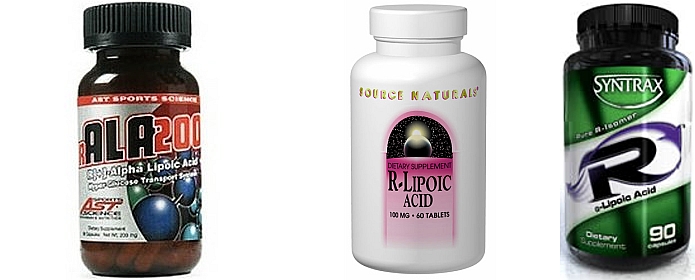Multi-purpose Supplements: Alpha Lipoic Acid

Alpha lipoic acid: Your Swiss Army Knife Supplement
With all the economic belt-tightening going on, lots of people are trimming down their supplement regimens. When it comes to getting to most bang for your supplement buck, there are few that hold a candle to alpha lipoic acid. Using inexpensive alpha lipoic acid (ALA) is like getting 3 or more supplements in one. You won’t believe how many different things ALA can do for you, but you’re about to find out in today’s AllStarHealth blog.
Lots of nutrients do more than one thing, but few have benefits as numerous and diverse as alpha lipoic acid, especially when you consider how affordable it is.
What is alpha lipoic acid? It’s not really a vitamin, since the body can produce it on its own. But like many vitamins, ALA functions as a versatile enzyme co-factor.. Enzymes are involved in just about every kind of biological activity within the body; they facilitate the chemical reactions that sustain life, health and activity at both the the cellular and organism level. Enzyme co-factor nutrients like B-vitamins, ALA and Co-Q10 speed up or enhance enzyme functions, benefiting the biological processes those enzyme systems support, from energy production to growth and tissue repair.
What are the benefits of ALA? It’s probably best-known as an antioxidant. But ALA is a unique antioxidant in several respects. It’s both water and fat-soluble, meaning it’s able to function both inside the cell and outside the cell in body fluids. As an antioxidant, ALA is also several times more powerful than others like vitamin C and vitamin E. . The main benefit of antioxidants is that they reduce oxidative stress on the body. That may not sound exciting, but oxidative stress is what’s behind almost every degenerative disease process and the general loss of function we associate with aging. That’s why antioxidants are so important.
ALA is also a potent liver detoxification agent. That’s because it’s a precursor to one of the liver’s primary detoxification compounds, the enzyme glutathione peroxidase.
Alpha lipoic acid also benefits blood-sugar balance by affecting the cellular uptake of glucose. That may seem like it’s something that’s only important to diabetics, but on the contrary, having efficient uptake of glucose is the key to achieving a lean, robust metabolism. So, while many diabetics do use ALA to manage problems like diabetic neuropathy, efficient uptake of glucose should be a key consideration for anyone looking for high, stable energy levels and stable weight.
How about eye health? Nutritional support for the eyes is a growing area of interest among supplement makers and the public. Antioxidants are vitally important for healthy eyes and vision. Animal studies using ALA have shown that it may protect against experimentally-induced cataracts and improve vision in some types of glaucoma. We’re seeing more and more eye formulas begin to include ALA along with other antioxidants like lutein and astaxanthin.
Every part of the body is vulnerable to oxidative stress, not only delicate structures like the eyes, but also bone. ALA may also be able to promote bone density by slowing the progression of cells called osteoclasts that dissolve bone tissue.
Skin is also very vulnerable to oxidative stress, which is why skin experts like Dr. Perricone advocate ALA supplements for beautiful and supple skin.
What about cardiovascular health? Oxidation is a major part of what makes LDL cholesterol harmful when it becomes harmful. Animal studies of ALA show that not only can it lower total cholesterol, it protects the LDL fraction from harmful oxidation. Another way alpha lipoic acid may benefit heart health is by supporting healthy blood pressure, especially in cases of salt-induced hypertension.
Besides being an antioxidant, alpha lipoic acid is also chelating agent. Chelators are able to bind with unused and potentially toxic minerals and metals, enabling them to be removed from the body. ALA is sometimes used, along with intravenous chelating agents, as part of physician-assisted chelation therapy in cases of metal and mineral poisoning. Without a doctor’s supervision and clinical tests, though, it’s very hard to quantify the chelating effects of ALA in terms of what metals were removed to what extent.
ALA has even more benefits than these. Few supplements offer such a wide range of support for such an affordable price. And there are very few people walking around who wouldn’t benefit from getting more antioxidant support in general. Young, old or in the middle, healthy or not-so-healthy, if it’s time to tighten up and consolidate your supplement regimen, you’ll want to save a place for ALA.
Of the ALA products on the market most consist of a 50/50 (or racemic mixture) of the R and S forms of lipoic acid. This form works, is the least expensive and delivers all of ALA’s benefits. However, recent evidence suggests that for a variety of reasons, it might be better to take only the R-form, especially if the primary goal is blood sugar support. Whether you use one form or the other, the dose range of ALA is very wide, but most people use 100-200 mg one to three times per day, with food. Work with your doctor as you use ALA in the context of any disease or concurrent with any medications.

R-lipoic acid supplements; the next generation




